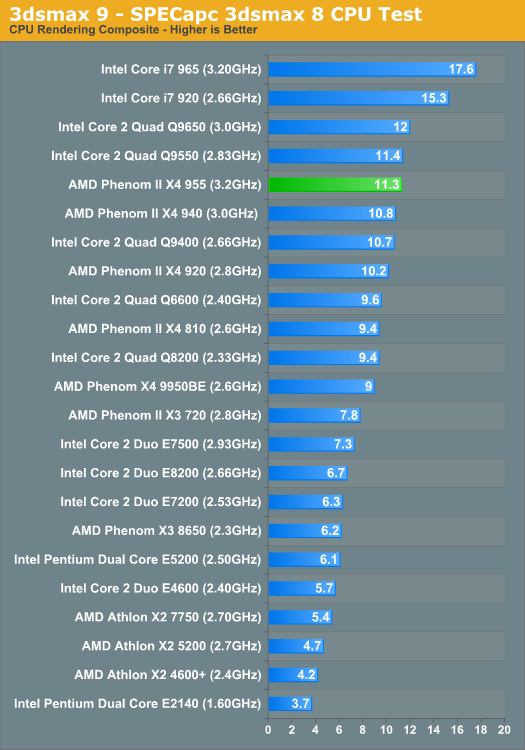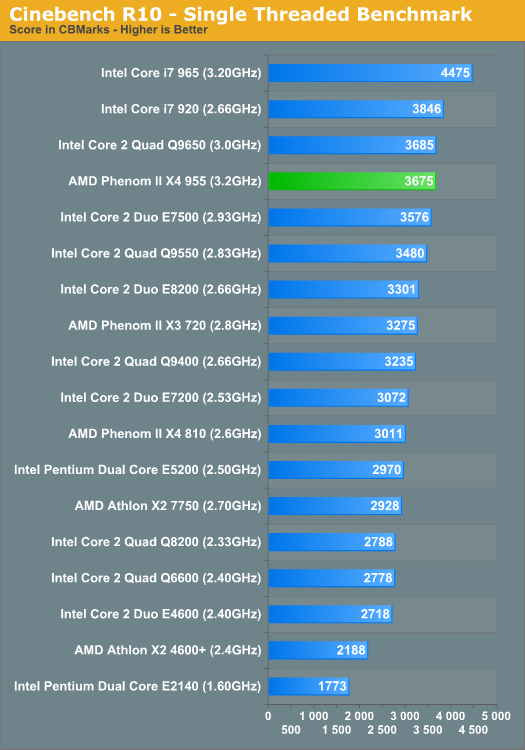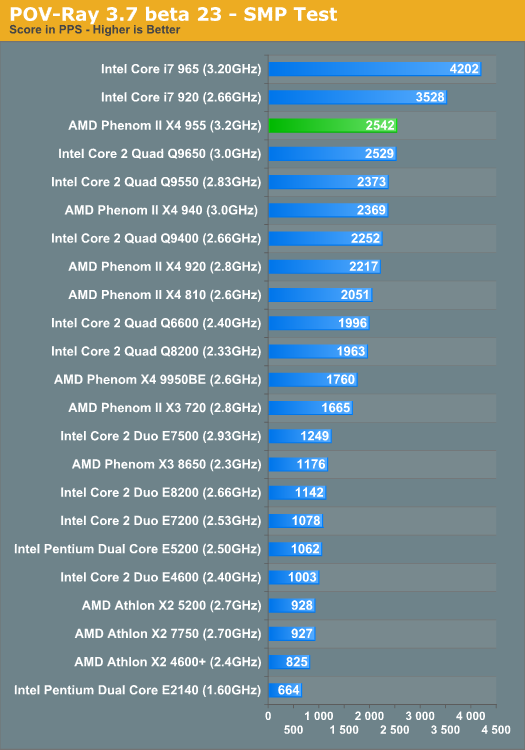AMD's Phenom II X4 955 Black Edition
by Anand Lal Shimpi on April 23, 2009 12:00 AM EST- Posted in
- CPUs
3dsmax 9 - SPECapc 3dsmax CPU Rendering Test
Today's desktop processors are more than fast enough to do professional level 3D rendering at home. To look at performance under 3dsmax we ran the SPECapc 3dsmax 8 benchmark (only the CPU rendering tests) under 3dsmax 9 SP1. The results reported are the rendering composite scores:

Even 3D rendering performance under 3dsmax 9 is quite competitive. Both the 955 and 940 are able to hang with the Q9400 and Q9550. Once again, the i7s hold a generational gap advantage in performance.
Cinebench R10
Created by the Cinema 4D folks we have Cinebench, a popular 3D rendering benchmark that gives us both single and multi-threaded 3D rendering results.

Single or multi-threaded, the 955 is faster than the Q9550 here. But if you're serious about 3D rendering you'll want the Core i7.

POV-Ray 3.73 beta 23 Ray Tracing Performance
POV-Ray is a popular, open-source raytracing application that also doubles as a great tool to measure CPU floating point performance.
I ran the SMP benchmark in beta 23 of POV-Ray 3.73. The numbers reported are the final score in pixels per second.











65 Comments
View All Comments
erple2 - Thursday, April 23, 2009 - link
But I think that's just it. The number of apps that use more than 2 cores is at quite a dearth, particularly given the 2 years since the 4 core processors started coming out in force.So that's just it. How many apps does one use that takes advantage of more than 2 cores? Personally, I have 2 - a compiler and an MP3 ripper. And the MP3 ripper is only marginally speedier with 2x as many cores.
So the point still stands from the Grandparent - Why do we need these 4 core behemoths (well, 4 cores with hyperthreading) when there are still so few applications that take advantage of those cores?
JimmiG - Thursday, April 23, 2009 - link
The BIOS updates situation is pretty sad. When I bought my M3A32-MVP Deluxe (790FX) board and a cheap lower-end Phenom X4, I was hoping that the board would allow me to use future 45nm Phenom CPUs without problems. That won't happen. Even though the board is technically compatible even with the 955, Asus will never release a BIOS update for this board. Asus likes to abandon its customers once the product is more than 6 months old.It's not only Asus's fault, though. AMD has been changing sockets like crazy for the last few years. S939/S754, AM2, AM2+, AM3.. Meanwhile Intel only switched sockets once with the move to i7.
slashbinslashbash - Thursday, April 23, 2009 - link
I agree, the BIOS situation is horrible. What is even worse is what you have to do to update a BIOS to use a newer processor. I will give an example, which I know is kind of extreme but it shows what's wrong with the situation.I bought an ASUS P5B a couple of years ago when CompUSA was going out of business. It was a good board for a cheap price. I didn't have any use for it at the time, as I had a good AMD S939 system running, but socked it away for future use. Couple of years later, I get a Celeron 430 + ECS mobo deal at Fry's for like $60. I put the CPU in and..... it doesn't even beep at me. I had to go and buy an ancient CPU (Pentium 630) just to get to the point where I could do the friggin' BIOS update to be able to run the newer Celeron. This, to me, is unacceptable. I'm not asking for full compatibility, just enough smarts to realize that this is a working processor plugged in, so can't we just run it at some minimum specs and pop up a "Please Update BIOS" message on the screen, and allow that BIOS update to run?
I totally understand CPU-mobo mismatches if the newer CPU requires a lower voltage or something like that. But, if the CPU is compatible, it ought to run in some minimal state necessary to at least load a BIOS update. Ideally, it would run some microkernel with networking that could automatically FTP the latest BIOS from the manufacturer; but that's probably too much to ask.
spunlex - Thursday, April 23, 2009 - link
Some motherboards do. My abit ip-35 pro ran my q9450 at 2.2Ghz, under the wrong name until I flashed the bios. So it is possible it seems to depend on the effort the board manufacturer is willing to make.strikeback03 - Thursday, April 23, 2009 - link
Just because a board uses Socket 775 doesn't necessarily mean it can use all S775 processors, my P965 board doesn't list compatibility with any 1333FSB processors.Roland00 - Thursday, April 23, 2009 - link
AMDSocket 939 June 2004
AM2 May 2006
AM2+ Nov 2007
AM3 February 2009
Intel
473 Nov 00
478 Aug 01
775 June 2004
1366 Nov 08
Now intel may recently have been not releasing new sockets as quickly as AMD, but during the Pentium 4 days from 473 to 478 to 775 they were releasing new sockets as quickly as AMD did during the AM2 era. And while you had the same socket 775 for 4 years it wasn't guaranteed that the newer cpus will work on your motherboard (see nvidia chipsets which wouldn't allow you to upgrade from a Pentium 4 to a Pentium d or a 65nm part to a 45 nm part). How is that different than AM2+ processors being compatible with AM2 boards if the bios maker just released a stupid bios.
JarredWalton - Thursday, April 23, 2009 - link
Let's not forget for socket 775 you had:Pentium 4 Northwood, Prescott - I don't *think* there was any compatibility issue here, though I'm sure some boards didn't support new Prescott chips, and of course there were new FSB speeds that required a new board/chipset
Pentium D Smithfield - yes, another chipset/board upgrade was needed.
Pentium D Presler - sadly, many boards didn't support this update either, since it used a 1066FSB.
Conroe/Allendale - definitely needs new board/chipset, but mostly compatible with all new "Core" CPUs.
Kentsfield - many boards wouldn't support quad core, so you needed to upgrade.
Wolfdale/Yorkfield - yet again, many need an updated board.
Or we could just list chipsets:
865/875 - adds 800FSB
910/915/920 - PCI-E and DDR2 support. Prescott also.
945/955 - 1066FSB and Pentium D
965/975 - Initial Core 2 chipsets; Core 2 Quad not supported on all boards
P35/X38 - adds support for 1333FSB, initial DDR3 support starts
P45 - Generally needed for Wolfdale/Yorkfield support
X48 - adds official 1600FSB (only needed for Q9770)
So while socket 775 has been around "forever", we have had no less than six chipset families in that time - and that's just the Intel chipsets. NVIDIA would add quite a few more to the mix. Naturally, AMD wasn't without fault - there were 939 boards that wouldn't work with dual-core chips, and later AM2 boards that don't work with Phenom. Now we have AM2+ that won't work with AM3 chips.
All this goes back to my general attitude of never purchasing a motherboard for its "future proof" capabilities. Get a board because it has what you want/need right now, and when it's time to upgrade then reevaluate your needs.
swaaye - Sunday, July 5, 2009 - link
My 'ol P965 board can technically run the latest Wolfdale CPU. You have to overclock the FSB to 1600, but that's no big deal really cuz I run a Conroe past that anyway lol. Gigabyte keeps things up to date as long as there isn't some serious hardware level incompatibility.Some 945 boards can run the latest stuff too as long as it's 800 FSB.
Really, the sockets change because the CPU maker figured out that the older spec didn't do the trick for some reason. I find it curious that people think that sockets should last for many CPU generations, as if the socket has little to do in the grand scheme of things.
crimson117 - Thursday, April 23, 2009 - link
Ditto... I got burned buying socket 939 x2 4400+ right when the it came out (July 2005), expecting to have a drop-in CPU upgrade in the next year or two. Boy was I pissed when it was replaced by Socket AM2 in May 2006, just 10 months later. (and also pissed that nothing much faster than the 4400+ was ever released on 939).Do they really get so much benefit from changing sockets that losing compatibility is worth it?
JarredWalton - Thursday, April 23, 2009 - link
I think honestly that a large percentage of chipset/mobo updates are to help companies make money and not for any serious benefit. It's usually at best a 2-5% boost in performance for stuff like new memory technology, tweaked chipset, etc.